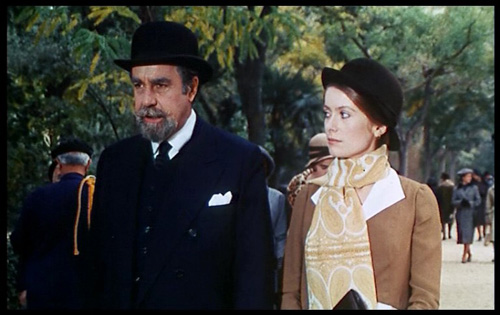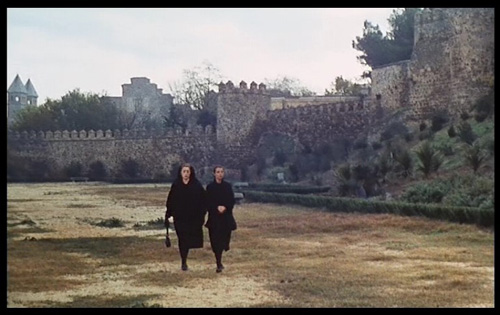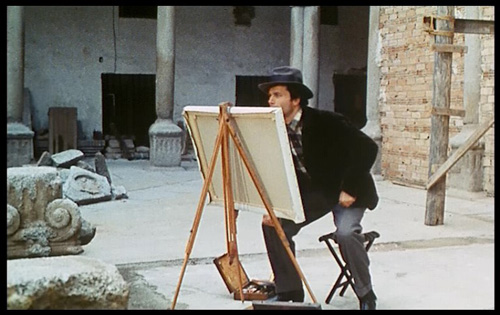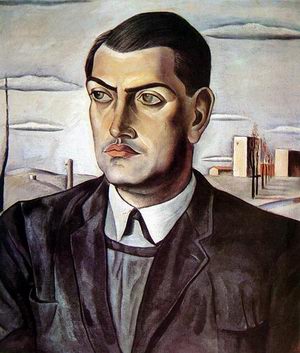Tristana, Luis Bunuel Blog-A-Thon
Written by Joe D on September 24th, 2007Portrait Of Bunuel by Dali
I’m writing about Tristana, a wonderful film starring Fernando Rey and Catherine Deneuve.

Main Title floating over Toledo- note cool lack of drop shadow
This was Bunuel’s 2nd film made in Spain after the war. A lot of the intellectuals, artists, musicians, left Spain when the Fascists took over, including Bunuel. But in the early 60’s Bunuel was persuaded or allowed to make Viridiana. The film was viewed as subversive and banned by the Spanish government. Luckily a print had been smuggled out of the country and it won the Palme D’Or at Cannes.

Predator and Prey Role Reversal on the way
So it took many years for Tristana to reach the silver screen. Bunuel wrote the screenplay in 1964 but because the Spanish government kept denying permission to film it, it didn’t go into production until 1969. But Bunuel wasn’t sitting around idly, he rewrote the script four times and I think that’s why the finished film is so polished and chock full of great images and ideas.

The Bishop of Toledo and Deneuve
Tristana is based on a short novel by Galdos, Bunuel had made Nazarin from a Galdos novel a few years before and he considered Galdos one of the greatest writers Spain has produced. Tristana was filmed in Toledo, a city Bunuel loved as a young man. While attending the Resedencia in Madrid he and a group of fellow students( Lorca, Alberti, Dali, etc.) formed an honorary society, the Order of Toledo. The rules were that you visited Toledo as often as possible and stayed up all night drinking and wandering it’s medieval streets.

Women In Black
Tristana really feels like a novel, the story, the characters are so detailed and finely drawn. Also it takes place over about 20 years or so which somehow adds to it’s literary pedigree. In the beginning Deneuve is an innocent girl who following the death of her mother becomes the ward of Fernando Rey. Don Lope (Rey) is an aging Don Juan, obsessed with chivalry, dueling, sticking up for the underdog but this does not prevent him from seducing the childlike girl he has taken in to protect. Tristana (Deneuve’s name in the movie) dreams of climbing a bell tower with a deaf mute boy (Saturno) she examines the huge bell and is horrified to find Don Lope’s head attached to the end of the clapper. She awakens from this nightmare screaming.

Tristana, let go of that huge penis, I mean bell clapper!
After being Don Lope’s concubine for a number of years Tristana meets a young artist Horacio (Franco Nero) she falls in love with him and runs off.

Unsuccessful Artist
A while later Horacio writes to Don Lope that Tristana is deathly ill and needs help. Don Lope fetches her back to his home. She is at death’s door and in order to save her life the doctor must amputate her leg. Don Lope is horrified but secretly overjoyed knowing she will never escape his clutches again. Tristana turns bitter and strange. As one critic said the star of the film is not Deneuve but her amputated leg! It certainly made a hit with Alfred Hitchcock, when he met Bunuel he kept saying” That Leg! That Leg!”.
Tristana exposes herself to the Masturbating Mute
The once shy girl exposes herself to the deaf mute Saturno from her balcony and tortures the aging Don Lope eventually killing him by leaving the window of his bedroom open as he struggles with pneumonia. Then Bunuel does a very strange thing. In rapid fashion he flashes a montage of clips that retell the story in reverse accompanied by the sound of a church bell playing in reverse. It works incredibly and since it is the end of the film there is no need to explain it or recover from it, the film is over. I last saw Tristana about 20 years ago at a special screening at the New York Film Festival in Lincoln Center. I don’t know if it ever came out on DVD but Hopefully you will be able to see it at a revival theater in 35mm the way it was intended to be seen.

I’m writing this as part of a Bunuel Blog-A-Thon, you can check out the rest of the blogs here:http://flickhead.blogspot.com/.
And here for your delectation is the trailer for Tristana



25
AM
Una precisión: el régimen del General Franco (1939- 1975) NO ERA fascista; era un régimen de autoridad y de orden público.
25
AM
Then why did all the great artists stay out of their homeland? Pablo Casals, Alberti, Neruda, Bunuel? Dali was pro monarchy and maybe even pro fascista.
25
PM
DalÃ, Don Camilo José Cela, Torrente Ballester, el Maestro Rodrigo (El Concierto de Aranjuez)…….
25
PM
Lorca?
25
PM
El régimen de Franco era muy similar al régimen del Dr. Oliveira Salazar, en Portugal, gran aliado de la Gran Bretaña.
25
PM
Importante libro sobre el asesinato de Federico GarcÃa Lorca, de Ian Gibson
25
PM
I will read it. Thanks for the recommendation.
26
PM
An excellent article and I agree: the film plays like a good novel. In that respect it’s most unlike Buñuel’s other films of the 1960s and ’70s. I have always found Deneuve’s icy detachment — made all the more remote by her dubbing — very unsettling. Off the top of my head, I can’t think of another character she played that was as darkly complex and manipulative.
Thank you for joining the blogathon and observing Mr. Buñuel.
26
PM
My pleasure, I was really obsessed with Bunuel about 20 years ago. I went to see Carlos Fuentes speak at Cooper Union in NYC at a memorial right after Bunuel died. They were good friends. Also if you get a chance check out films by Arturo Ripstien ( a Mexican film director) another close friend of Bunuel. They’re hard to come by but worth the effort.
26
PM
I see that Netflix will be renting a documentary on Buñuel and Emilio Fernández, a director best known as an actor — Mapache in The Wild Bunch:
http://www.netflix.com/Movie/Grandes_Directores/70078460?trkid=147042
11
PM
great post
kodak shopping